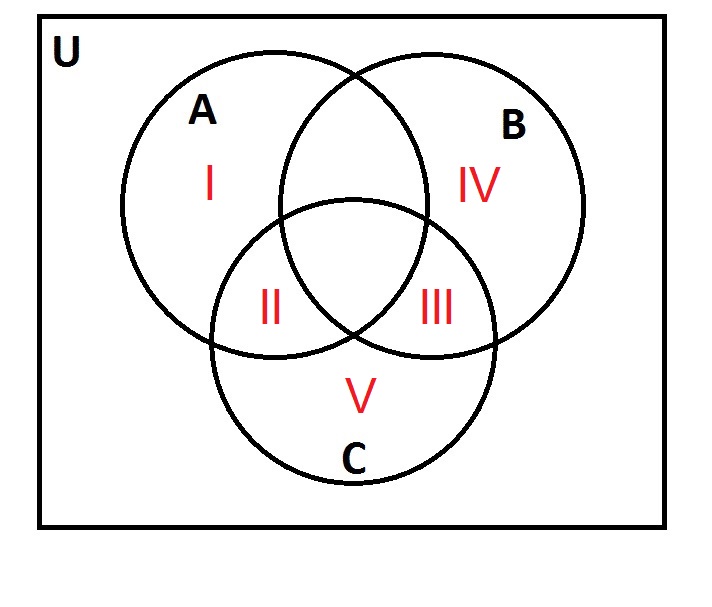All ISEE Upper Level Quantitative Resources
Example Questions
Example Question #4 : Venn Diagrams
In a group of 



Cannot be determined
Based on the information given, you can draw the following Venn Diagram:

Now, you must begin by solving for 







Now, we can find the number of people with only books by subtracting 


Example Question #5 : Data Analysis And Probability

Examine the above Venn diagram. Let 



James Abram Garfield was born in Ohio in 1831. In which region would he fall?
IV
I
III
V
II
V
Carter would not fall in set A, since he was not a President born in Virginia.
He would not fall in B, since he was born before 1850.
He would fall in C, since his first name is James.
He would fall in the region included in set C, but not A or B - this is Region V.
Example Question #6 : Data Analysis And Probability

Examine the above Venn diagram. Let 



James Earl Carter was born in Georgia in 1924. In which region would he fall?
V
IV
II
III
I
III
Carter would not fall in set A, since he was not a President born in Virginia.
He would fall in B, since he was born after 1850.
He would fall in C, since his first name is James.
He would fall in the region included in sets B and C, but not A - this is Region III.
Example Question #9 : Venn Diagrams

Examine the above Venn diagram. Let universal set 
Let 


Which of the following would be a subset of the set represented by the shaded region in the diagram?
Note: for purposes of this question, "Y" is considered a consonant.
{price, value, pinna, trove, three}
{eagle, uvula, apnea, unsee, abide}
{usher, aspen, ester, order, earth}
{catfish, division, rot, status, giving}
{potato, tomato, breeze, mimosa, magnolia}
{price, value, pinna, trove, three}
The subset must comprise words that fall inside set 


Therefore, all of the words in the subset must have exactly five letters, but cannot begin with a vowel or end with a consonant - that is, we are looking for a set of five-letter words that begin with a consonant and end with a vowel.
The only set among the five choices that matches this description is the set
{price, value, pinna, trove, three}.
Example Question #7 : Data Analysis And Probability

Examine the above Venn diagram. Let universal set 
Let 


Which of the following would be a subset of the set represented by the shaded region in the diagram?
Note: for purposes of this question, "Y" is considered a consonant.
{plateau, portmanteau, calliope, marionette, taco}
{tomato, potato, ravine, cabana, marine}
{autism, enough, ideals, occult, unduly}
{autistic, estrogen, ideology, opal, understand}
{apnea, esoterica, irradiate, opulence, uvula}
{plateau, portmanteau, calliope, marionette, taco}
The subset must comprise words that fall inside sets 


Of the given choices, the only set whose elements fit this description is {plateau, portmanteau, calliope, marionette, taco}.
Example Question #11 : Data Analysis
What is the greatest common factor of 

To solve for the greatest common factor, it is necessary to get your numbers into prime factor form. For each of your numbers, this is:
Next, for each of your sets of prime factors, you need to choose the exponent for which you have the smallest value; therefore, for your values, you choose:



Taking these together, you get:
Example Question #12 : Data Analysis

For the Venn Diagram pictured above, what is the value 
Solving for the overlap of two sets is easy when you have all of your data. You know that the two circles added up will have to equal 



Because the overlap happens once in each circle, you know that:
Given your data, you know:
Solving, this means:

Example Question #1 : How To Find The Common Part Of A Venn Diagram

For the Venn Diagram pictured above, what is the value 
No answer possible.
Solving for the overlap of two sets is easy when you have all of your data. You know that the two circles added up will have to equal 



Because the overlap happens once in each circle, you know that:
Given your data, you know:
Solving, this means: 

Example Question #2 : How To Find The Common Part Of A Venn Diagram

For the Venn Diagram pictured above, what is the value 
Solving for the overlap of two sets is easy when you have all of your data. You know that the two circles added up will have to equal 



Because the overlap happens once in each circle, you know that:
Given your data, you know:
Solving, this means:

Example Question #15 : Data Analysis

For the Venn Diagram pictured above, what is the value 
No answer is possible.
No answer is possible.
Do not be tricked by this question! In order to solve for the overlap, you need to know the amount that is in the area outside of the circles but still inside the universal box area! You cannot figure out the answer without knowing this fact; therefore, you must select "No answer is possible." We know that the two circles do not exhaust the universe because 


Certified Tutor
Certified Tutor
All ISEE Upper Level Quantitative Resources


















































